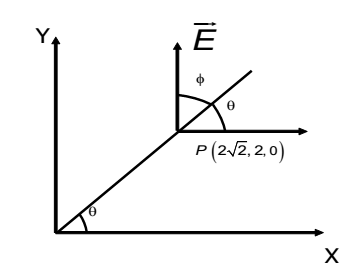
A small electric dipole is placed at origin with its dipole moment directed along positive x-axis. The direction of electric field at point $\left( {2,2\sqrt {2,0} } \right)$is:
(A) Along z-axis
(B) Along y-axis
(C) Along negative y-axis
(D) Along negative z-axis
Answer
515.6k+ views
Hint Electric dipole is defined as a couple of opposite charges q and -q separated by a distance of d. The direction of the electric dipoles in the space is always from negative charge -q to the positive charge q. Based on this concept this question is to be solved.
Step-by step answer
The electric field due to a dipole at any point in space is given by,
$E = \dfrac{1}{{\left( {4\pi {\varepsilon _0}{r^3}} \right)\left( {3(\vec p \cdot \hat r)\hat r - p} \right)}}$
So, we can write that:
$r = 2\hat i + 2\sqrt {2j} \Rightarrow \hat r = \dfrac{1}{{\sqrt {3i} }} + \sqrt {\dfrac{2}{3}\hat j}$
The value of $\operatorname{Tan} \theta = \dfrac{y}{x} = \dfrac{{2\sqrt 2 }}{2} = \sqrt 2$
Hence the value of E is given by:
$E = \dfrac{1}{{\left( {4\pi {\varepsilon _0}{r^3}} \right)(\sqrt 3 p\hat rp\hat i)}}$
The i component cancels out leaving only the j component.
Form the figure we can see that:

From the figure,
$\operatorname{Tan} \phi = \cot \theta$ so,
$\phi = 90 - \theta$
Now $\vec E$ is along + y-axis
Hence, the correct answer is Option B.
Note Electric field is defined as the electric force per unit charge. The direction of the field is taken to be the direction of the force it would exert on a positive test charge. The electric field radially outward from a positive charge and radially in toward a negative point charge.
Step-by step answer
The electric field due to a dipole at any point in space is given by,
$E = \dfrac{1}{{\left( {4\pi {\varepsilon _0}{r^3}} \right)\left( {3(\vec p \cdot \hat r)\hat r - p} \right)}}$
So, we can write that:
$r = 2\hat i + 2\sqrt {2j} \Rightarrow \hat r = \dfrac{1}{{\sqrt {3i} }} + \sqrt {\dfrac{2}{3}\hat j}$
The value of $\operatorname{Tan} \theta = \dfrac{y}{x} = \dfrac{{2\sqrt 2 }}{2} = \sqrt 2$
Hence the value of E is given by:
$E = \dfrac{1}{{\left( {4\pi {\varepsilon _0}{r^3}} \right)(\sqrt 3 p\hat rp\hat i)}}$
The i component cancels out leaving only the j component.
Form the figure we can see that:

From the figure,
$\operatorname{Tan} \phi = \cot \theta$ so,
$\phi = 90 - \theta$
Now $\vec E$ is along + y-axis
Hence, the correct answer is Option B.
Note Electric field is defined as the electric force per unit charge. The direction of the field is taken to be the direction of the force it would exert on a positive test charge. The electric field radially outward from a positive charge and radially in toward a negative point charge.
Recently Updated Pages
[Awaiting input: Please provide the content from "Ask AI Response," "Competitor 1," and "Competitor 2," so I can perform the analysis and synthesize the requested metadata and headings.]

Young’s Double Slit Experiment Derivation Explained

A square frame of side 10 cm and a long straight wire class 12 physics JEE_Main

The work done in slowly moving an electron of charge class 12 physics JEE_Main

Two identical charged spheres suspended from a common class 12 physics JEE_Main

According to Bohrs theory the timeaveraged magnetic class 12 physics JEE_Main

Trending doubts
JEE Main 2026: Application Form Open, Exam Dates, Syllabus, Eligibility & Question Papers

Derivation of Equation of Trajectory Explained for Students

Hybridisation in Chemistry – Concept, Types & Applications

Understanding the Angle of Deviation in a Prism

How to Convert a Galvanometer into an Ammeter or Voltmeter

Degree of Dissociation: Meaning, Formula, Calculation & Uses

Other Pages
JEE Advanced Marks vs Ranks 2025: Understanding Category-wise Qualifying Marks and Previous Year Cut-offs

Dual Nature of Radiation and Matter Class 12 Physics Chapter 11 CBSE Notes - 2025-26

Ideal and Non-Ideal Solutions Explained for Class 12 Chemistry

Understanding the Electric Field of a Uniformly Charged Ring

Understanding Electromagnetic Waves and Their Importance

Essential Derivations for CBSE Class 12 Physics: Stepwise & PDF Solutions




